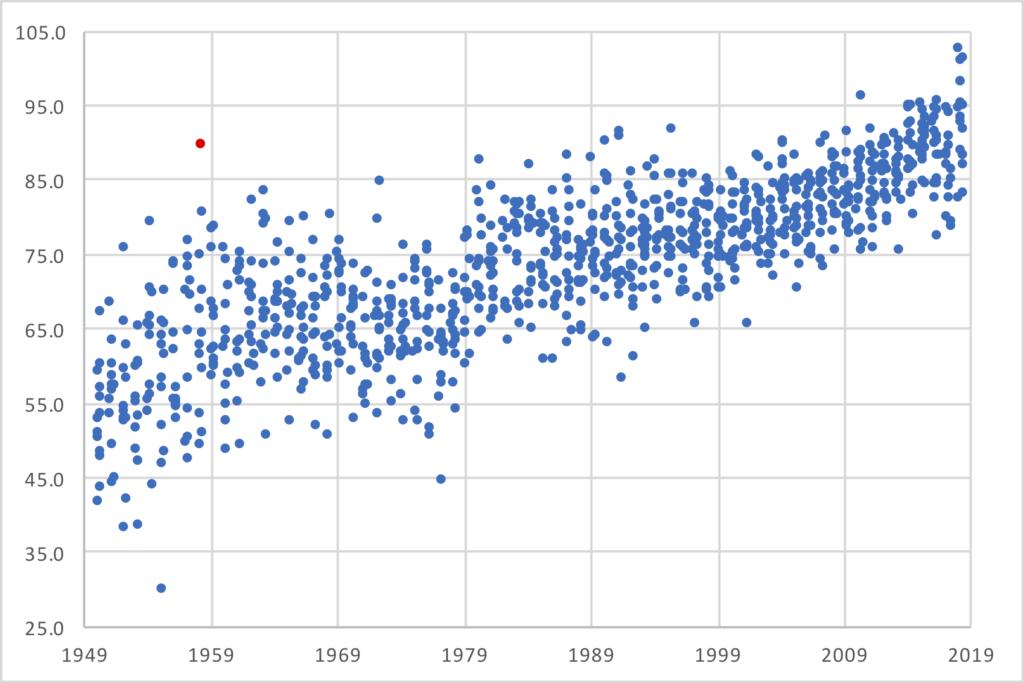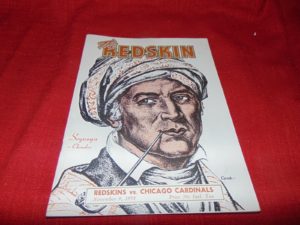The graph below shows the passer rating in every week of every NFL season since 1950. The red dot at the top left? That’s the passer rating from week 7, 1958, when six games all took place on Sunday, November 9th.
 November 9th, 1958 should be remembered as the greatest passing day of the NFL’s first 50 years. It was a star-studded day with names even modern fans will recognize. Two of the best quarterbacks of the 1960s, Bart Starr and Norm Van Brocklin, were starters that day, while the 49ers saw both future MVP John Brodie and Hall of Famer Y.A. Tittle take the field. And all four lost.
November 9th, 1958 should be remembered as the greatest passing day of the NFL’s first 50 years. It was a star-studded day with names even modern fans will recognize. Two of the best quarterbacks of the 1960s, Bart Starr and Norm Van Brocklin, were starters that day, while the 49ers saw both future MVP John Brodie and Hall of Famer Y.A. Tittle take the field. And all four lost.
The day featured a preview of the eventual title game that year, as Charlie Conerly, one of the best quarterbacks not in the Hall of Fame led the Giants to a win over the Baltimore Colts. Fortunately for Baltimore, while George Shaw played well on this day — he had a 88.1 passer rating, going 11/29 for 239 yards with 3 TDs and 1 interception — the team would have injured quarterback Johnny Unitas back for the championship game, which turned out to be pretty memorable.
As good as Starr, Van Brocklin, Brodie, Tittle, and Conerly may have been in general, all five were below-average passers that week. The week instead belonged to one Hall of Famer and four forgotten men from the fifties: Bobby Layne, Tobin Rote, Billy Wade, Lamar McHan,and Eddie LeBaron. And the Hall of Famer had the worst week of the bunch.
The average passer rating in week 7 of the 1958 season was 89.9. Overall, NFL passers completed 161 of 309 passes for 2,576 yards, with 29 TDs and just 16 interceptions. It was the high touchdown rate (9.4%) that really juiced passer rating for the week, although it was an above-average week for the other three metrics (completion percentage, yards per attempt, and interception rate), too.
Let’s start with Layne, who shows a quirk in the passer rating formula. Layne completed 10 of 22 passes for a whopping 225 yards with 4 touchdown passes and two interceptions, as he out-dueled Van Brocklin’s Eagles. Layne finished with a passer rating of 84.3, which of course was below average for the week. But that’s only because of the caps on the individual variables in passer rating: Layne threw a touchdown on 18% of his passes, but the passer rating formula does not give extra credit for any touchdown rate above 11.875%. If we discard Layne’s numbers, the league-wide passer rating that week would drop from 89.9 to 88.8, because losing 4 touchdowns on 22 passes and a 10 yards/attempt average is pretty meaningful (and in the aggregate, Layne’s touchdowns are capped out). But because Layne doesn’t get full credit in the formula for his touchdown rate, he actually checks in at below average.
The four real stars of the week have no such issue.
Tobin Rote was the best player on the field in the Lions/Browns game. The Detroit quarterback had a stat line straight out of 2018: 17/30 for 246 yards with 3 TDs and no interceptions or sacks. He threw touchdown passes of 4, 13, and 34 yards, and guided the Lions to an easy win.
Billy Wade and the Rams produced the blowout of the week, winning 56-7 over the 49ers team with Brodie and Tittle. A rookie Frank Ryan came off the bench and threw the final touchdown pass of the game, rubbing some salt in San Francisco’s wounds. Wade hit 1958 breakout star Del Shofner for touchdowns of 64 and 72 yards, and Wade also ran for a 17-yard touchdown. He finished the day a remarkable 14 of 19 for 256 yards and 4 TDs, the first game in 8 seasons where a passer had 4+ TDs and a 150+ passer rating. Wade had a 155.2 passer rating, the highest passer rating of the week.
The most compelling contest of the week, however, was in Washington, D.C. On paper, this was a sad matchup between two losing teams going nowhere. The Redskins were coached by Joe Kuharich, in his final year with the team before he resigned to head back to Notre Dame. The Chicago Cardinals were coached by Pop Ivy, who joined the team in 1958 after a remarkable run as head coach in the CFL.
Washington had 5’7 Eddie LeBaron at quarterback in those days, and on November 9th, 1958, he had the game of his career: LeBaron completed 15 of 23 passes for 267 yards, with 5 TDs and 0 interceptions. From 1950 to 1965, there were just 5 games where a passer had 5+ TDs, 0 INTs, and averaged 10 yards per attempt, and all five such quarterbacks were active on November 9th, 1958.
LeBaron and the Redskins jumped out to a 45-10 lead, as he connected on two touchdown passes to Jim Podoley and three to Joe Walton. But that’s when the Cardinals’ Lamar McHan took over. The former Razorback was the 2nd overall pick in the 1954 Draft, and would head to Green Bay the next season. He began the day as a backup to rookie M.C. Reynolds, and he would return to the bench the next week. But in the second half of this game, he produced monster numbers. In the third quarter, he hit Woodley Lewis on touchdown strikes of 58 and 34 yards. McHan finished the game by goign 12 of 18 for 276 yards with 4 TDs and two interceptions, a 109.7 passer rating. For McHan, it was a career high in passing yards and one of only three times in his career that he threw four touchdowns. But it was too little, too late, as Washington won, 45-31.
Thanks to LeBaron, Wade, McHan, and Rote, this was (at the time) the best passing week in NFL history. Without those 4 players, the league-wide passer rating would have dropped from 89.9 to 63.6, the result of removing a third of the stars from a 12-team league. But it wasn’t just those four: Layne played well for the Lions, and both quarterbacks in the Colts/Giants game finished with passer ratings in the 80s, well-above average for that era. The only dud of a game was in Chicago, where the Bears and Packers had miserable passing attacks. In fact, remove that game, and the other 10 teams that week combined for a remarkable 101.0 passer rating! And that game featured a pair of Hall of Fame quarterbacks who would win multiple titles in the ’60s and take the same field in the Super Bowl. In addition to Starr, George Blanda was the Bears backup quarterback that day, and he and Starr shared the same field in Super Bowl II nine years later. Even when the passing was bad on November 9th, 1958, there was still a silver lining to come.

